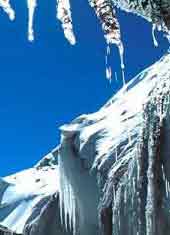The Himalayas, the mind-blowing marvel …!

Goddess Mahalakshmi became a bhir tree to protect Lord Narayana who was doing penance from rain and fog!
The sthalam has always attracted sages and yogis. It is at a height of 3,100 meters from the sea level and is situated in natural surrounding that is not polluted by anything. Alaknanda River flows by its side. Saraswathi, Douli, Mandakini and Pindar, the tributaries originate here. Badrivanam is full of bhir (elanthai) trees. Badhri means bhir in Sanskrit. Sthala history says that Goddess Mahalakshmi became a bhir tree to protect Lord Narayana who was doing penance from rain and fog. The belief is that one cannot attain mukti without a darshan of this Badri. Also, it is believed that some verses of the old Rigveda were written here. The stretch from Nandaprayag to Sadhobandh is called Badrivishal. The officer in charge of the temple consults astrologers and pandits on the date of opening the temple after the winter season is over. Also, the date for the closing of the temple before winter sets in is decided after consultation with astrologers. When the temple is closed, the chief priest, along with the staff goes to Joshimutt. He’ll stay there until the temple is reopened. Till that time, the worship for Lord Badrinath is done only in Joshimutt.
There is no historical evidence for the date of the Badrinath temple. Adi Sankara got a Saligram when he dipped in Naradagunda. He installed it near Thapthagunda and Garuda statue. During the 5th century, the king of Garwal, who was suffering from leprosy, installed the deity at the present place on the advice of Varadaraja Acharya, and was relieved of his disease, it is said.
Badrinath is portrayed in Padmasana posture. Milk, honey abhishekams are performed. At 4 p.m.., a Namboodri offers worship service with Vishnu Sshasranamam and Gitagovindam. The priest is called Raval. From the days of Adi Sankara, only Kerala Namboodris retain the right to offer the services to Badrinath. They are appointed jointly by the temple committee and the king of Garwal. We can have darshan of Badrinath at five places – Vishalbadri, Yogabadri, Bavishyabadri, Vridhabadri and Adibadri. We all got the happiness for our life when we had His darshan on both Friday evening and Saturday morning. When we achieve things amongst hardships, our joy doubles. Badrinath is a more developed place than Kedarnath. There are even three-star hotels.
When we were in the temple, we felt the earth moving under our feet. We learned that there were severe earthquakes in Pakistan and Kashmir at that time and that its impact had been felt in Badrinath. We decided to leave after lunch. We wanted to go to Mana, an interior helmet on the Indo-Pakistan border in the meantime. There are many caves on the way to Mana from Badrinath. It is believed that yogis and sages did penance here. We visited some of the caves and the temple for Saraswathi at the spot where the river originated. The river merges with Alknanda at this point itself. Mana is at a height of 3,700 meters. There are Indian army camps. If we travel a distance of 8 km from here on the Border Road, we can see the frontier of China. Some of the people in Mana were seen begging to the passers-by. The sight was pathetic. They surely need a minimum comfortable life. It is the duty of the government of Uthranjal to look into this matter. Let Badrinath make those responsible feel their responsibility!

